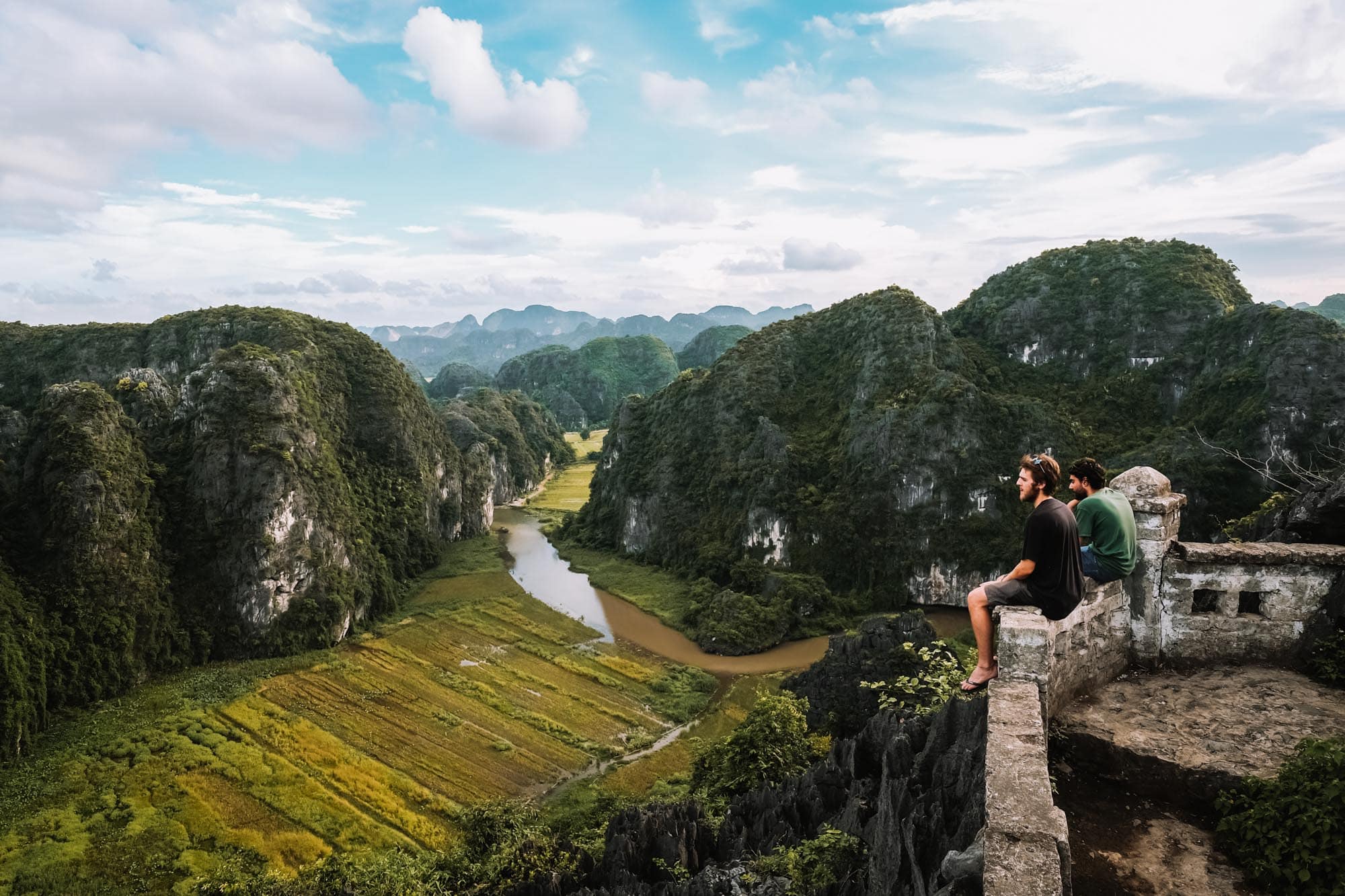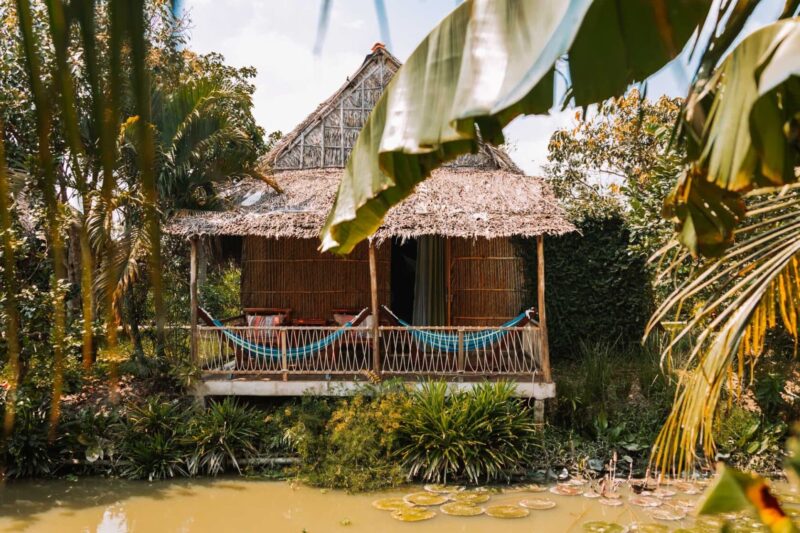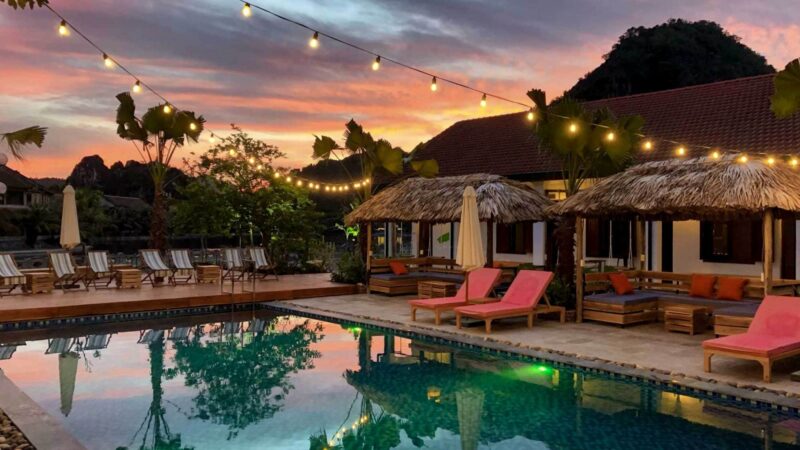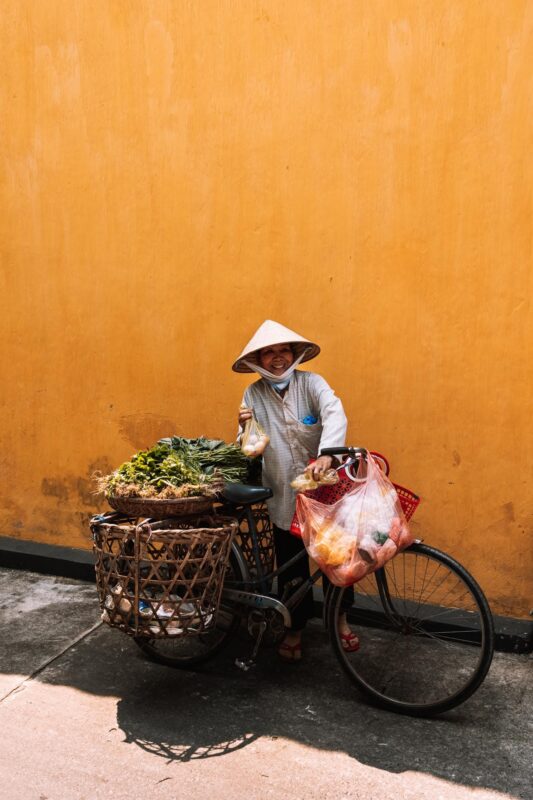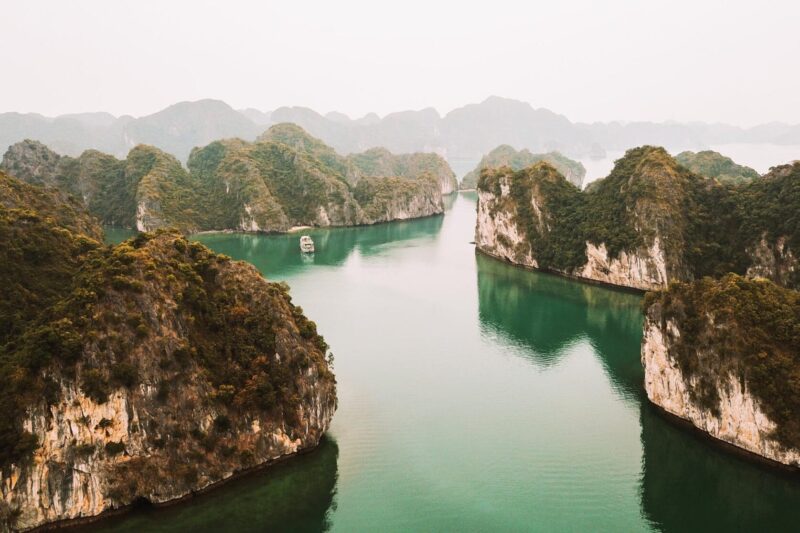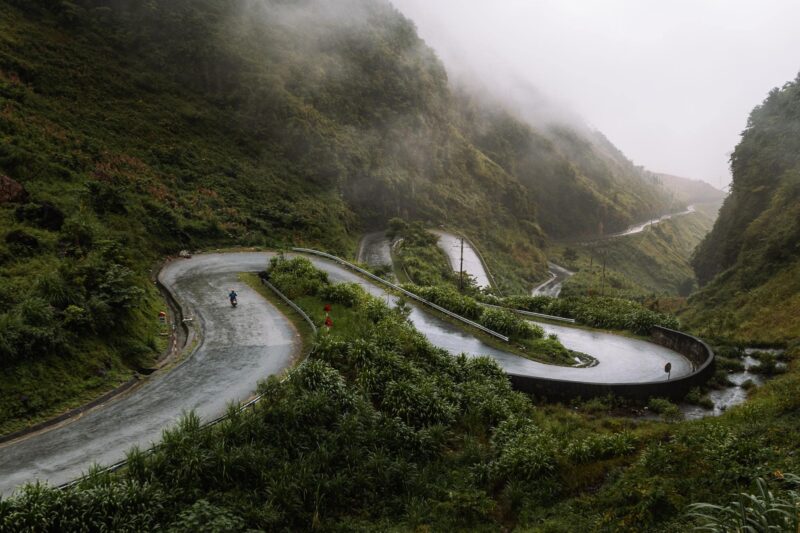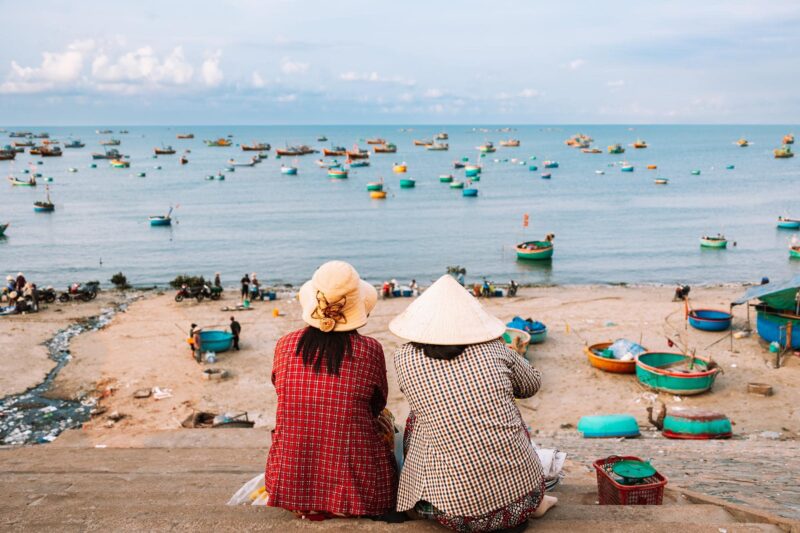Creating an itinerary for Vietnam can be a bit complex as it’s a vast country with many beautiful places to choose from. We’ve put together an exciting itinerary full of tips that will take you to all the highlights of Vietnam. You’ll journey through the expansive rice terraces in the north, the impressive Halong Bay, vibrant cities, charming Hoi An, and the authentic Mekong Delta. If you have more time, we’ll also suggest a few other beautiful destinations at the bottom that you can add to or adjust in your itinerary.
Determining the Direction of Your Vietnam Itinerary
When traveling through Vietnam, you can choose to visit the north, the south, or both. Most travelers opt to explore both the north and the south to experience the country’s diversity fully. With this itinerary, you’ll be covering the entire country.
You can start your journey in either Hanoi in the north or Ho Chi Minh City in the south, as both cities have international airports. Generally, people find the north of Vietnam a bit more picturesque than the south, which you can consider when deciding on your travel direction. Another factor to consider is the price of flight tickets. Sometimes, it’s cheaper to fly to Hanoi, and other times, it’s more affordable to choose Ho Chi Minh City. Ideally, you can fly into one city and depart from the other, saving you the need for an additional domestic flight. We’ve chosen to plan the itinerary from north to south, but you can easily reverse it to fit your preferences.
How Does Transportation Work in Vietnam?
Vietnam stretches for about 1,600 kilometers (994 miles) from the extreme north to the far south. You can travel across Vietnam by bus, train, or airplane, depending on the route. Buses run between all destinations, and for longer journeys, you can often take a night bus or night train. This way, you can sleep comfortably, save money on hotels, and find it less tiring than traveling during the day. For longer distances, you can also opt for a flight, although this is usually a bit more expensive. You can arrange transportation locally or book online. The advantage of booking online is that you can compare all providers and options, read reviews, and be sure you’re paying a fair price.
Tip: We’ve written separate articles about almost all the places on this Vietnam itinerary, providing tips for the most enjoyable activities and how to get there from various other destinations. These articles include all the options and travel durations.
How Many Weeks Do You Need for This Vietnam Itinerary?
To complete this entire Vietnam itinerary, you’ll need about three weeks. If you have less time, you can skip some destinations. If you have more time or want to explore more of the north, you’ll find additional tips for beautiful destinations to expand your itinerary at the end of this article. Read our articles with tips for these destinations to easily decide how to allocate your days among the various places.

Hanoi
Hanoi is the bustling capital of Vietnam and a great introduction to the country due to its abundance of exciting activities and attractions. You may experience a bit of a cultural shock as Hanoi is quite a chaotic city. On every street corner, you’ll find street food stalls, and scooters zoom in all directions around you. Start your journey with a cool street food tour or seek tranquility in one of the many temples, such as the enchanting Temple of Literature. Curious about what else there is to do? Check out all the tips for Hanoi.
Sapa
After a few days getting used to Hanoi, it’s time to leave the hustle and bustle behind and travel to the green mountain village of Sapa. Sapa is located in the far north, nestled among mountains covered in gigantic rice terraces. It’s the perfect destination for a beautiful hike. Walk along viewpoints, through valleys with authentic villages, and take a dip in a waterfall. Make sure to also take a ride on the longest non-stop cable car in the world, then stand on the highest peak in Vietnam. Interested in what else there is to do? Read about the 10 best things to do in Sapa.
Note: It’s best to visit Sapa only from June to September. In May, farmers plant new rice, and from that point on, the rice terraces become greener. September offers the most beautiful views of the rice terraces. Sapa is not recommended in the winter months when it’s very cold, the landscapes are bare, and it’s often foggy.
Halong Bay & Cat Ba
Halong Bay is one of the most iconic destinations in Vietnam, thanks to its breathtaking landscapes. The rock formations, nearly 500 million years old, form an archipelago of thousands of small islands. These rocks were once part of a gigantic coral reef, and some are hundreds of feet high. Cat Ba is the largest island in Halong Bay and the most common base for visiting the bay. The best way to explore Halong Bay is on a one- or two-day cruise. Get on board the boat and enjoy the beauty that Halong Bay has to offer. It’s most enjoyable to join a cruise that also visits lesser-known spots. That’s how you experience the best of Halong Bay. Find out which one in the article with tips for Halong Bay.

Ninh Binh
Ninh Binh is an enchanting province and an absolute must-visit during your journey through Vietnam. Amidst the rock formations, sometimes towering up to 200 meters (656 feet), you’ll find green rice fields, rivers, lakes, and caves. In Ninh Binh, you’ll completely relax and experience the authentic countryside life of Vietnam. Hop on a bike or scooter and explore the winding roads that meander through the rice fields. The nature in Ninh Binh is breathtaking, and life there is delightfully uncomplicated. Among the rice fields, you’ll find the most beautiful accommodations, often with a spectacular view. All of this makes Ninh Binh one of the most enjoyable places on your Vietnam itinerary. Check out the tips for Ninh Binh to make the most of your visit.
Phong Nha
From here, your journey to Hoi An in central Vietnam begins. You can cover this long journey by night train or easily divide it into two parts by planning a visit to Phong Nha on your itinerary. Here, you can visit two impressive caves named Paradise Cave and Phong Nha Cave. You can rent a scooter and explore the caves on your own or book the combination tour where you visit both caves. This includes transportation, admission, and lunch.
Tip: In Phong Nha, you can stay at a special place called Karst Villas Phong Nha. From here, you’ll have a breathtaking view from the pool over the landscape.

Hoi An
Hoi An is the favorite city of most travelers in Vietnam. It’s a small town by Vietnamese standards that offers the best of both worlds. You’ll find the charm of the old town but also a beautiful beach, and within 15 minutes, you’ll be in the middle of rice fields. Here, you can seek both the hustle and tranquility. Hoi An exudes atmosphere and coziness with its beautiful historical houses, colorful lanterns, numerous excellent restaurants, and lovely shops. Curious about what Hoi An has to offer? I’ve listed the best things to do in Hoi An for you.
Ho Chi Minh City
If you’re visiting the southern part of Vietnam, you can’t miss Ho Chi Minh City. It’s the largest city in the country with a population of 9 million. Don’t spend too much time here because it’s not the most exciting city. District 1 is a popular district among travelers, and you’ll find most of the attractions, restaurants, bars, and hotels here. End your day in Ho Chi Minh City with a cocktail at one of the rooftop bars. From here, you’ll have a view of the entire metropolis as the sun slowly sets. Check out all the tips for Ho Chi Minh City.
Mekong Delta
After a day in Ho Chi Minh City, it’s time to escape the hustle and bustle, and the best way to do that is in the Mekong Delta. This is a unique water landscape consisting of hundreds of small rivers. People here mainly live on and along the water. You’ll find floating markets where various food items like coconuts, fish, meat, and fruit are traded. It’s a unique destination that you shouldn’t miss if you want to experience the real life of Vietnam. Cycle along the canals and over small bridges and wave to the friendly locals you’ll encounter everywhere. It’s best to stay on the outskirts of Can Tho. There, you’ll find some beautiful small-scale hotels located by the water where you can experience an oasis of tranquility. Read all the tips for the Mekong Delta to make the most of your visit.
Other Exciting Destinations for Your Vietnam Itinerary
For the above Vietnam itinerary, you’ll need about three weeks. This, of course, depends on your travel style and pace. If you want to customize or expand this itinerary, there are more exciting destinations in Vietnam to consider. You can choose to explore more of the north or the south. Below, we’ll suggest a few beautiful destinations that you can add to or adjust your Vietnam itinerary.
Phu Quoc
If you want to end your journey through Vietnam on a pristine white beach with azure blue waters, plan a few more days on the island of Phu Quoc on your itinerary. It’s located at the southernmost point of Vietnam, and you can fly there from Ho Chi Minh City, for example. As soon as you set foot on the island, the enjoyment begins. Go island hopping and snorkeling for a day or just relax at one of the beach clubs. If you have the time, Phu Quoc is a delightful way to end your trip! Check out all the tips for Phu Quoc to get a good impression of the island.
Ha Giang Loop
If you want to explore more of northern Vietnam in an adventurous way, Ha Giang is the perfect destination for this. Here, you can embark on the famous Ha Giang Loop by motorcycle, taking a cool road trip through various small villages. Along the way, you’ll be treated to spectacular views of the rugged mountain landscapes. You can rent a motorcycle yourself, or you can ride with an “easy rider,” which is a typical Vietnamese concept where you travel with a guide on the back of their motorcycle. This is often done in groups, making it a fun road trip with plenty of beautiful stops and enjoyable evenings. Check out all the tips for the Ha Giang Loop.

Cao Bang
In the far north, near the border of China, lies the lush province of Cao Bang. This province is quite remote, but the impressive Ban Gioc Waterfall and Phong Nam Valley make it well worth the trip. Here, you’ll truly venture off the beaten path, encountering few English speakers. There’s still much to discover, and it doesn’t get much more authentic than this. Check out our tips for Cao Bang to get a good sense of this unique destination.
Mui Ne
If you choose to travel overland from Hoi An to Ho Chi Minh City, a stop in Mui Ne is recommended. This way, you can split the journey in two and visit this fishing village with its vast sand dunes. It’s also a popular spot among surfers and windsurfers. Even if you have no experience with (wind)surfing, it can be fun to take a lesson here and brave the waves. Check out all the tips for Mui Ne if you want to add this stop to your southern Vietnam itinerary.
Our Favorite Places to Stay in Vietnam
During all our travels, we search for the most pleasant and unique places to stay. Vietnam is a fantastic destination in this regard because here, you can sleep at unique locations with stunning views for relatively little money. We’ve already compiled a list of our favorite accommodations in Vietnam by destination. We always recommend a cozy hostel and a special hotel for those looking for a bit more luxury. Staying at these delightful accommodations will surely enhance your trip!

